Child, Adolescent and Family Nursing
VerifiedAdded on 2023/06/06
|10
|2797
|131
AI Summary
This essay discusses the pathophysiology of appendicitis, peritonitis and gangrenous perforated appendix in a 10-year-old patient. It also evaluates the role of the nurse in the care of the patient and the importance of family-centered care.
Contribute Materials
Your contribution can guide someone’s learning journey. Share your
documents today.
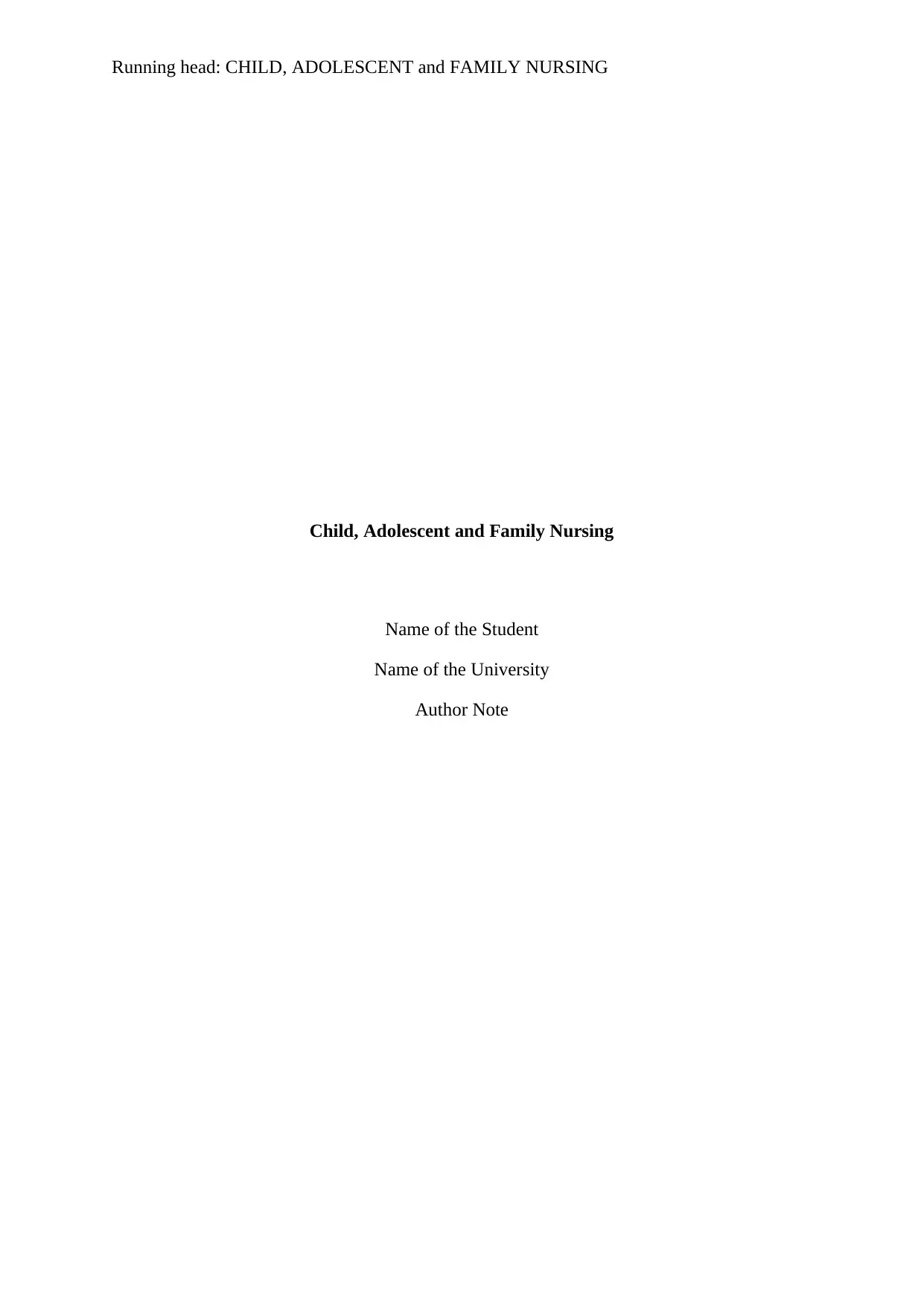
Running head: CHILD, ADOLESCENT and FAMILY NURSING
Child, Adolescent and Family Nursing
Name of the Student
Name of the University
Author Note
Child, Adolescent and Family Nursing
Name of the Student
Name of the University
Author Note
Secure Best Marks with AI Grader
Need help grading? Try our AI Grader for instant feedback on your assignments.

1CHILD, ADOLESCENT and FAMILY NURSING
Introduction:
Discussed below is the case study of a 10 year old patient who was presented to the
Emergency Department with right iliac fossa pain, which led to the suspicion of appendicitis.
Further evaluation by the surgical team revealed that the patient had a gangrenous perforated
appendix with peritonitis. The aim of the essay is to develop understanding of the
pathophysiology of the condition and outline the role of the nurse in the care of patient.
Description of the pathophysiology of the presenting complaint
Appendicitis:
This is a condition that is caused due to the inflammation of the appendix. The
appendix is a vestigial organ, and lies at the end of the colon on the lower right side of the
abdomen. The appendicitis is caused to a blockage of the inner lining of the appendix leading
to an infection (Matsushita et al., 2018). The infection is caused due to the proliferation of
bacteria which results in the inflammation and swelling of the appendix. The obstruction of
the appendicidal lumen can be caused due to an increased pressure due to secretion of excess
mucous and fluids by the mucosa of the lumen (Petroianu & Barroso, 2016). The bacteria of
the intestine that are in the appendix starts to proliferate which triggers the recruitment of
white blood cells leading to an inflammatory response and formation of pus (Allievi et al.,
2017).
Peritonitis:
Peritoneum is a serous membrane that lines the abdominal cavity and the abdominal
organs. Inflammation of this membrane is known as peritonitis (Oliver, 2017). The
inflammation can be caused due to several reasons such as a wound in the abdomen, ruptured
appendix, and perforations in the colon, pancreatitis, diverticulitis, pelvic inflammatory
Introduction:
Discussed below is the case study of a 10 year old patient who was presented to the
Emergency Department with right iliac fossa pain, which led to the suspicion of appendicitis.
Further evaluation by the surgical team revealed that the patient had a gangrenous perforated
appendix with peritonitis. The aim of the essay is to develop understanding of the
pathophysiology of the condition and outline the role of the nurse in the care of patient.
Description of the pathophysiology of the presenting complaint
Appendicitis:
This is a condition that is caused due to the inflammation of the appendix. The
appendix is a vestigial organ, and lies at the end of the colon on the lower right side of the
abdomen. The appendicitis is caused to a blockage of the inner lining of the appendix leading
to an infection (Matsushita et al., 2018). The infection is caused due to the proliferation of
bacteria which results in the inflammation and swelling of the appendix. The obstruction of
the appendicidal lumen can be caused due to an increased pressure due to secretion of excess
mucous and fluids by the mucosa of the lumen (Petroianu & Barroso, 2016). The bacteria of
the intestine that are in the appendix starts to proliferate which triggers the recruitment of
white blood cells leading to an inflammatory response and formation of pus (Allievi et al.,
2017).
Peritonitis:
Peritoneum is a serous membrane that lines the abdominal cavity and the abdominal
organs. Inflammation of this membrane is known as peritonitis (Oliver, 2017). The
inflammation can be caused due to several reasons such as a wound in the abdomen, ruptured
appendix, and perforations in the colon, pancreatitis, diverticulitis, pelvic inflammatory

2CHILD, ADOLESCENT and FAMILY NURSING
disease, Crohn’s Disease or infections of the gall bladder, bloodstream or intestine. The
inflammation is caused when bacteria gets in contact with the peritoneum through a rupture
in the GI tract (Ross et al., 2018).
Gangrenous Perforated Appendix:
A gangrenous and perforated Appendix is the sign of an acute stage of Appendicitis in
which the walls of the appendix starts to die and decay leading to perforations and acute
peritonitis (Alvarado, 2018). This is caused due to an extreme form of inflammation leading
to gangrenous appendix due to blockage of the lumen of the appendix, obstructing blood
flow. The perforations are then caused due to the formation of gangrenous tissues deprived of
oxygen and nutrients from blood (Lotti, 2017). Thrombosis in the appendicular artery due to
the increased pressure also leads to perforation and gangrene of the appendix (Gorter et al.,
2017).
Evaluation of the role of nurse:
Related Growth and Developmental Theories:
The patient is 10 years old girl, who had to remain admitted to the hospital for a long
time in order to manage her condition and prevent complications before undergoing surgery.
She is completely dependent on her parents and thus it is vital for the nurses to understand the
implications of the hospital stay on her overall wellbeing. This can be understood in the
context of some of the developmental theories that explains the stages of development and
behavioral changes occurring in the child in the course of development and maturation. Some
of the developmental theories applicable in this context include:
Attachment Theory by Bowlby:
disease, Crohn’s Disease or infections of the gall bladder, bloodstream or intestine. The
inflammation is caused when bacteria gets in contact with the peritoneum through a rupture
in the GI tract (Ross et al., 2018).
Gangrenous Perforated Appendix:
A gangrenous and perforated Appendix is the sign of an acute stage of Appendicitis in
which the walls of the appendix starts to die and decay leading to perforations and acute
peritonitis (Alvarado, 2018). This is caused due to an extreme form of inflammation leading
to gangrenous appendix due to blockage of the lumen of the appendix, obstructing blood
flow. The perforations are then caused due to the formation of gangrenous tissues deprived of
oxygen and nutrients from blood (Lotti, 2017). Thrombosis in the appendicular artery due to
the increased pressure also leads to perforation and gangrene of the appendix (Gorter et al.,
2017).
Evaluation of the role of nurse:
Related Growth and Developmental Theories:
The patient is 10 years old girl, who had to remain admitted to the hospital for a long
time in order to manage her condition and prevent complications before undergoing surgery.
She is completely dependent on her parents and thus it is vital for the nurses to understand the
implications of the hospital stay on her overall wellbeing. This can be understood in the
context of some of the developmental theories that explains the stages of development and
behavioral changes occurring in the child in the course of development and maturation. Some
of the developmental theories applicable in this context include:
Attachment Theory by Bowlby:
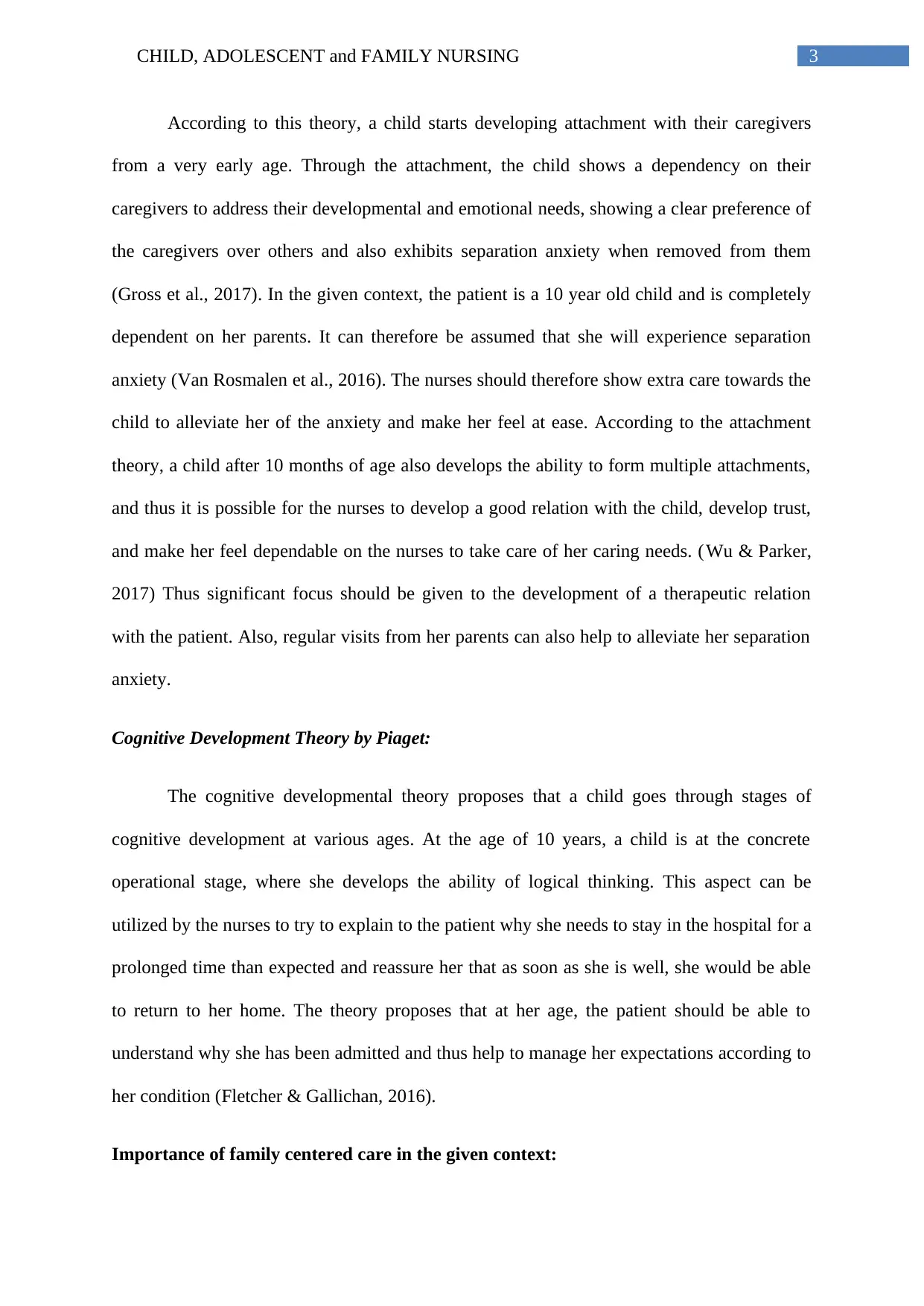
3CHILD, ADOLESCENT and FAMILY NURSING
According to this theory, a child starts developing attachment with their caregivers
from a very early age. Through the attachment, the child shows a dependency on their
caregivers to address their developmental and emotional needs, showing a clear preference of
the caregivers over others and also exhibits separation anxiety when removed from them
(Gross et al., 2017). In the given context, the patient is a 10 year old child and is completely
dependent on her parents. It can therefore be assumed that she will experience separation
anxiety (Van Rosmalen et al., 2016). The nurses should therefore show extra care towards the
child to alleviate her of the anxiety and make her feel at ease. According to the attachment
theory, a child after 10 months of age also develops the ability to form multiple attachments,
and thus it is possible for the nurses to develop a good relation with the child, develop trust,
and make her feel dependable on the nurses to take care of her caring needs. (Wu & Parker,
2017) Thus significant focus should be given to the development of a therapeutic relation
with the patient. Also, regular visits from her parents can also help to alleviate her separation
anxiety.
Cognitive Development Theory by Piaget:
The cognitive developmental theory proposes that a child goes through stages of
cognitive development at various ages. At the age of 10 years, a child is at the concrete
operational stage, where she develops the ability of logical thinking. This aspect can be
utilized by the nurses to try to explain to the patient why she needs to stay in the hospital for a
prolonged time than expected and reassure her that as soon as she is well, she would be able
to return to her home. The theory proposes that at her age, the patient should be able to
understand why she has been admitted and thus help to manage her expectations according to
her condition (Fletcher & Gallichan, 2016).
Importance of family centered care in the given context:
According to this theory, a child starts developing attachment with their caregivers
from a very early age. Through the attachment, the child shows a dependency on their
caregivers to address their developmental and emotional needs, showing a clear preference of
the caregivers over others and also exhibits separation anxiety when removed from them
(Gross et al., 2017). In the given context, the patient is a 10 year old child and is completely
dependent on her parents. It can therefore be assumed that she will experience separation
anxiety (Van Rosmalen et al., 2016). The nurses should therefore show extra care towards the
child to alleviate her of the anxiety and make her feel at ease. According to the attachment
theory, a child after 10 months of age also develops the ability to form multiple attachments,
and thus it is possible for the nurses to develop a good relation with the child, develop trust,
and make her feel dependable on the nurses to take care of her caring needs. (Wu & Parker,
2017) Thus significant focus should be given to the development of a therapeutic relation
with the patient. Also, regular visits from her parents can also help to alleviate her separation
anxiety.
Cognitive Development Theory by Piaget:
The cognitive developmental theory proposes that a child goes through stages of
cognitive development at various ages. At the age of 10 years, a child is at the concrete
operational stage, where she develops the ability of logical thinking. This aspect can be
utilized by the nurses to try to explain to the patient why she needs to stay in the hospital for a
prolonged time than expected and reassure her that as soon as she is well, she would be able
to return to her home. The theory proposes that at her age, the patient should be able to
understand why she has been admitted and thus help to manage her expectations according to
her condition (Fletcher & Gallichan, 2016).
Importance of family centered care in the given context:
Secure Best Marks with AI Grader
Need help grading? Try our AI Grader for instant feedback on your assignments.

4CHILD, ADOLESCENT and FAMILY NURSING
Implementing a family centered care is an important strategy in the given scenario,
since it helps to include family in the delivery of care for the patient. Family centered care is
a nursing strategy that recognizes the importance of family in the life of a child; supports
collaboration between the family, healthcare professionals and the child at all the levels of
healthcare service; regularly updating the child’s family on the care given to their child;
identifying the strengths of the family and incorporating it to help the care delivery;
recognizing and respecting diversities, individuality and strengths in the family; supporting
family to family networking; developing comprehensive strategies that can support the child
as well as the family and designing a flexible service that incorporates the opinions and views
of the family as needed (Smith et al., 2015). To ensure family centered care, healthcare
providers should understand the need of information by the child’s family, provide them
support and reassurance and helping the family to be with the child during the treatment
(Regan et al., 2017).
In the given context, family centered care can be ensured by different strategies. The
first strategy is educating the nurses and other healthcare providers on the need of the
patient’s family in the care of the patient. The second strategy is to help the healthcare staff to
liaison with the family members, relaying information to them whenever needed. Thirdly,
hospital volunteers can be employed as family caregivers to share non medical information
and give support and comfort to them. Fourthly, the visiting hours can be made flexible to
allow the family members to visit the patient when they want (Coyne, 2015). Additionally,
different tools can be used to meet the information need of the family, such as booklets and
clinical reports, which can help them to understand the patient’s condition, diagnosis, and
ongoing treatment and thus help to set up realistic expectations. Overall, the family of the
patient should be given consistent attention to understand their needs and dissipate their
concerns and alleviate their anxiety. Helping to reduce the anxiety of the parents can
Implementing a family centered care is an important strategy in the given scenario,
since it helps to include family in the delivery of care for the patient. Family centered care is
a nursing strategy that recognizes the importance of family in the life of a child; supports
collaboration between the family, healthcare professionals and the child at all the levels of
healthcare service; regularly updating the child’s family on the care given to their child;
identifying the strengths of the family and incorporating it to help the care delivery;
recognizing and respecting diversities, individuality and strengths in the family; supporting
family to family networking; developing comprehensive strategies that can support the child
as well as the family and designing a flexible service that incorporates the opinions and views
of the family as needed (Smith et al., 2015). To ensure family centered care, healthcare
providers should understand the need of information by the child’s family, provide them
support and reassurance and helping the family to be with the child during the treatment
(Regan et al., 2017).
In the given context, family centered care can be ensured by different strategies. The
first strategy is educating the nurses and other healthcare providers on the need of the
patient’s family in the care of the patient. The second strategy is to help the healthcare staff to
liaison with the family members, relaying information to them whenever needed. Thirdly,
hospital volunteers can be employed as family caregivers to share non medical information
and give support and comfort to them. Fourthly, the visiting hours can be made flexible to
allow the family members to visit the patient when they want (Coyne, 2015). Additionally,
different tools can be used to meet the information need of the family, such as booklets and
clinical reports, which can help them to understand the patient’s condition, diagnosis, and
ongoing treatment and thus help to set up realistic expectations. Overall, the family of the
patient should be given consistent attention to understand their needs and dissipate their
concerns and alleviate their anxiety. Helping to reduce the anxiety of the parents can
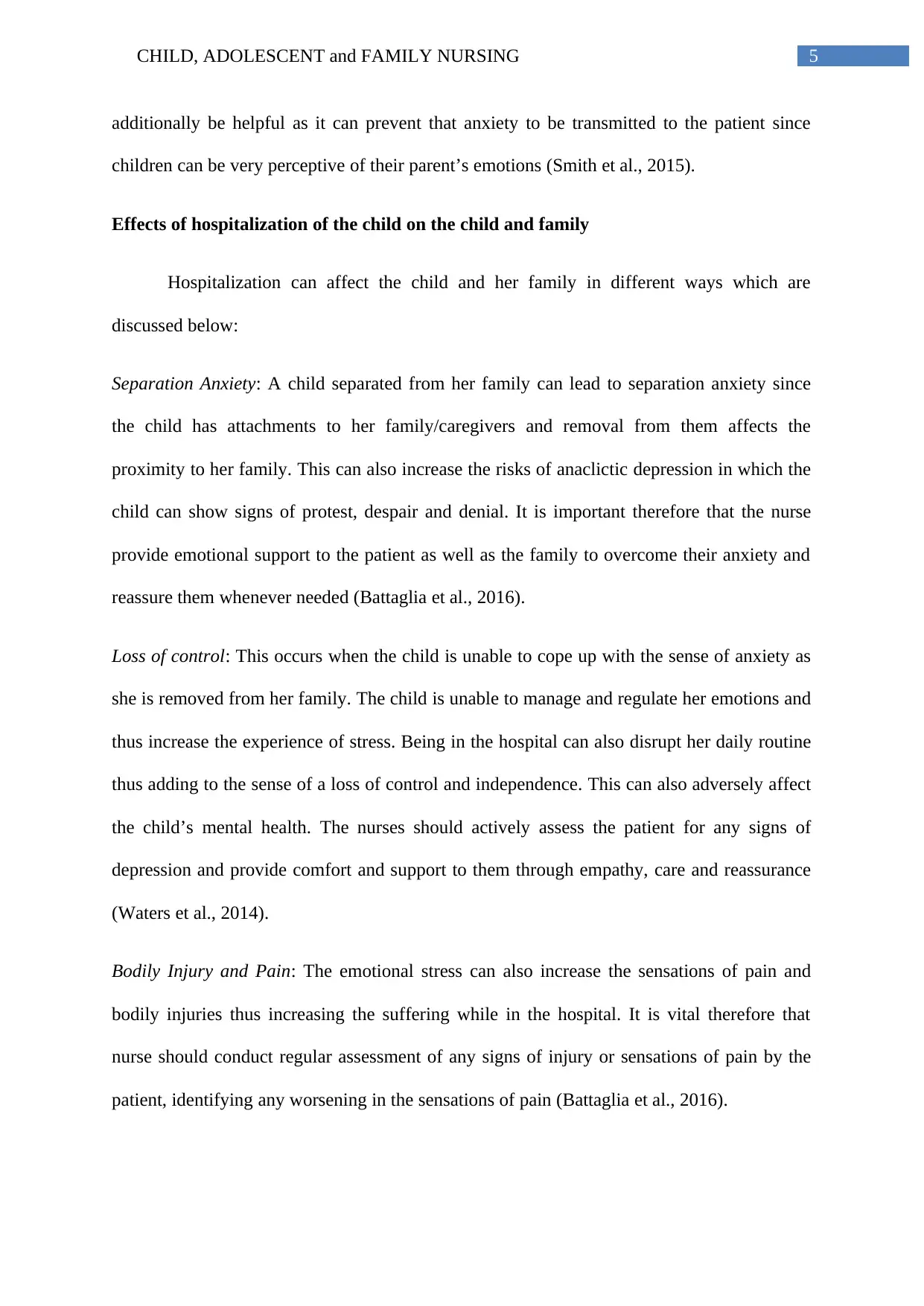
5CHILD, ADOLESCENT and FAMILY NURSING
additionally be helpful as it can prevent that anxiety to be transmitted to the patient since
children can be very perceptive of their parent’s emotions (Smith et al., 2015).
Effects of hospitalization of the child on the child and family
Hospitalization can affect the child and her family in different ways which are
discussed below:
Separation Anxiety: A child separated from her family can lead to separation anxiety since
the child has attachments to her family/caregivers and removal from them affects the
proximity to her family. This can also increase the risks of anaclictic depression in which the
child can show signs of protest, despair and denial. It is important therefore that the nurse
provide emotional support to the patient as well as the family to overcome their anxiety and
reassure them whenever needed (Battaglia et al., 2016).
Loss of control: This occurs when the child is unable to cope up with the sense of anxiety as
she is removed from her family. The child is unable to manage and regulate her emotions and
thus increase the experience of stress. Being in the hospital can also disrupt her daily routine
thus adding to the sense of a loss of control and independence. This can also adversely affect
the child’s mental health. The nurses should actively assess the patient for any signs of
depression and provide comfort and support to them through empathy, care and reassurance
(Waters et al., 2014).
Bodily Injury and Pain: The emotional stress can also increase the sensations of pain and
bodily injuries thus increasing the suffering while in the hospital. It is vital therefore that
nurse should conduct regular assessment of any signs of injury or sensations of pain by the
patient, identifying any worsening in the sensations of pain (Battaglia et al., 2016).
additionally be helpful as it can prevent that anxiety to be transmitted to the patient since
children can be very perceptive of their parent’s emotions (Smith et al., 2015).
Effects of hospitalization of the child on the child and family
Hospitalization can affect the child and her family in different ways which are
discussed below:
Separation Anxiety: A child separated from her family can lead to separation anxiety since
the child has attachments to her family/caregivers and removal from them affects the
proximity to her family. This can also increase the risks of anaclictic depression in which the
child can show signs of protest, despair and denial. It is important therefore that the nurse
provide emotional support to the patient as well as the family to overcome their anxiety and
reassure them whenever needed (Battaglia et al., 2016).
Loss of control: This occurs when the child is unable to cope up with the sense of anxiety as
she is removed from her family. The child is unable to manage and regulate her emotions and
thus increase the experience of stress. Being in the hospital can also disrupt her daily routine
thus adding to the sense of a loss of control and independence. This can also adversely affect
the child’s mental health. The nurses should actively assess the patient for any signs of
depression and provide comfort and support to them through empathy, care and reassurance
(Waters et al., 2014).
Bodily Injury and Pain: The emotional stress can also increase the sensations of pain and
bodily injuries thus increasing the suffering while in the hospital. It is vital therefore that
nurse should conduct regular assessment of any signs of injury or sensations of pain by the
patient, identifying any worsening in the sensations of pain (Battaglia et al., 2016).
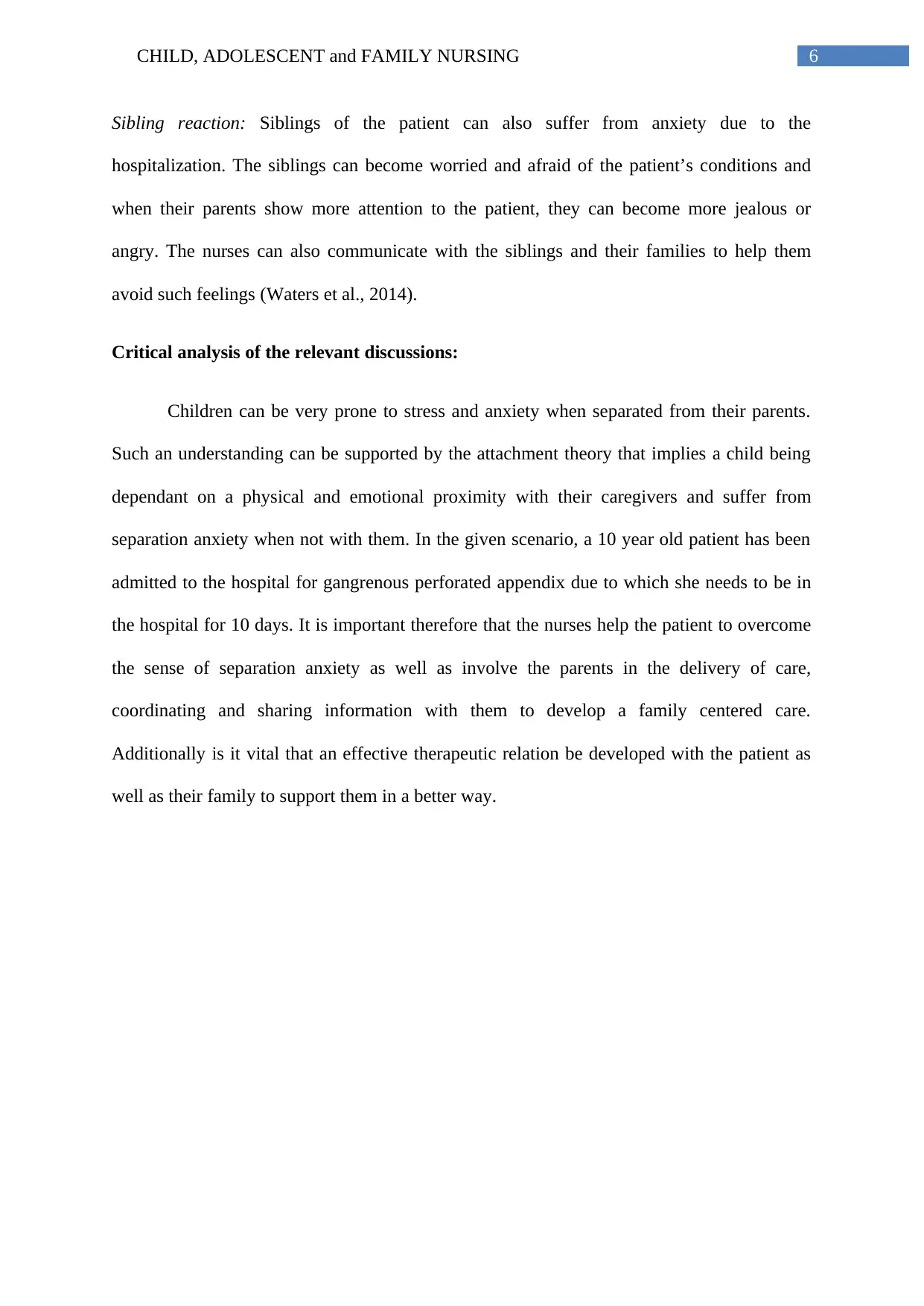
6CHILD, ADOLESCENT and FAMILY NURSING
Sibling reaction: Siblings of the patient can also suffer from anxiety due to the
hospitalization. The siblings can become worried and afraid of the patient’s conditions and
when their parents show more attention to the patient, they can become more jealous or
angry. The nurses can also communicate with the siblings and their families to help them
avoid such feelings (Waters et al., 2014).
Critical analysis of the relevant discussions:
Children can be very prone to stress and anxiety when separated from their parents.
Such an understanding can be supported by the attachment theory that implies a child being
dependant on a physical and emotional proximity with their caregivers and suffer from
separation anxiety when not with them. In the given scenario, a 10 year old patient has been
admitted to the hospital for gangrenous perforated appendix due to which she needs to be in
the hospital for 10 days. It is important therefore that the nurses help the patient to overcome
the sense of separation anxiety as well as involve the parents in the delivery of care,
coordinating and sharing information with them to develop a family centered care.
Additionally is it vital that an effective therapeutic relation be developed with the patient as
well as their family to support them in a better way.
Sibling reaction: Siblings of the patient can also suffer from anxiety due to the
hospitalization. The siblings can become worried and afraid of the patient’s conditions and
when their parents show more attention to the patient, they can become more jealous or
angry. The nurses can also communicate with the siblings and their families to help them
avoid such feelings (Waters et al., 2014).
Critical analysis of the relevant discussions:
Children can be very prone to stress and anxiety when separated from their parents.
Such an understanding can be supported by the attachment theory that implies a child being
dependant on a physical and emotional proximity with their caregivers and suffer from
separation anxiety when not with them. In the given scenario, a 10 year old patient has been
admitted to the hospital for gangrenous perforated appendix due to which she needs to be in
the hospital for 10 days. It is important therefore that the nurses help the patient to overcome
the sense of separation anxiety as well as involve the parents in the delivery of care,
coordinating and sharing information with them to develop a family centered care.
Additionally is it vital that an effective therapeutic relation be developed with the patient as
well as their family to support them in a better way.
Paraphrase This Document
Need a fresh take? Get an instant paraphrase of this document with our AI Paraphraser
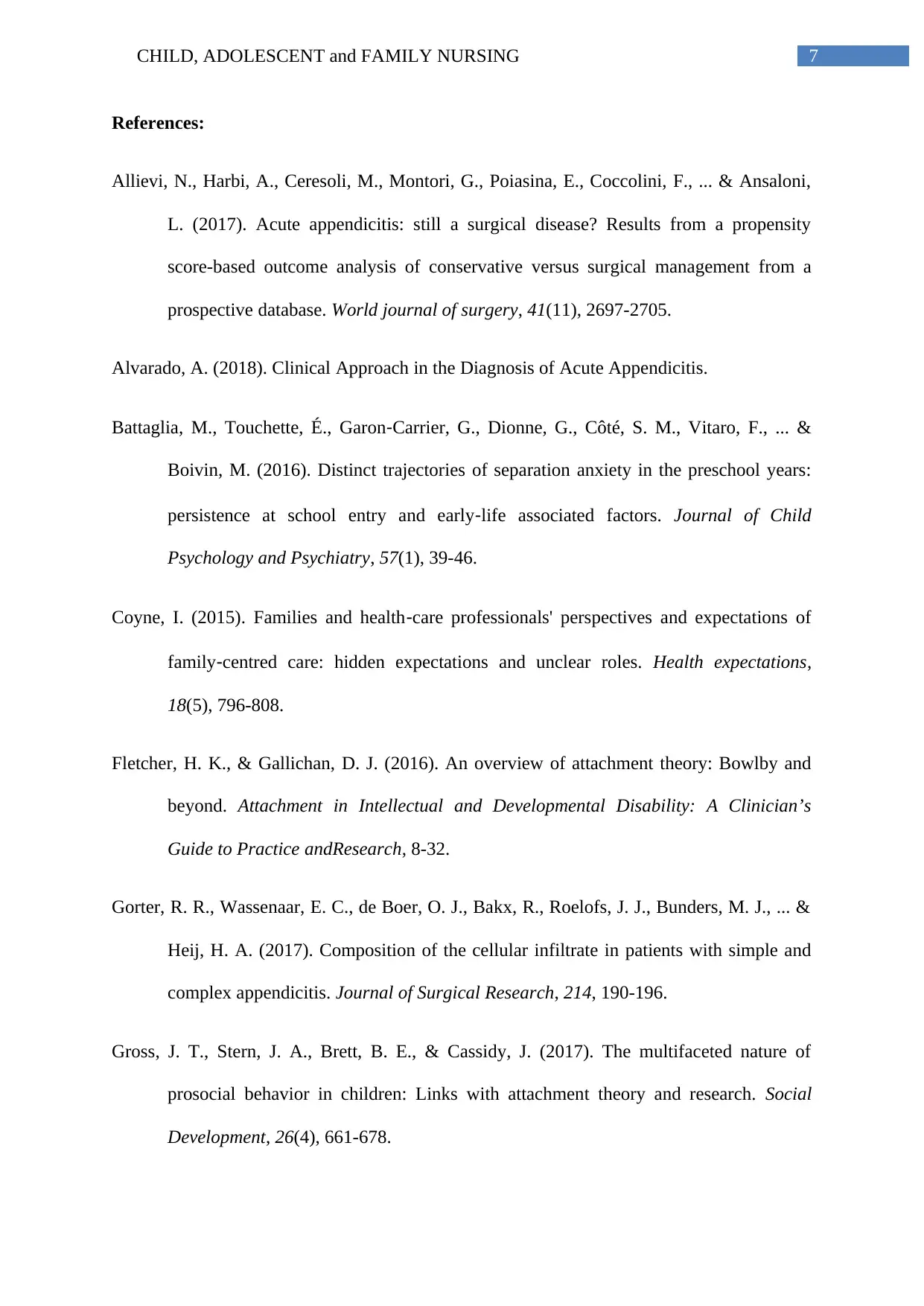
7CHILD, ADOLESCENT and FAMILY NURSING
References:
Allievi, N., Harbi, A., Ceresoli, M., Montori, G., Poiasina, E., Coccolini, F., ... & Ansaloni,
L. (2017). Acute appendicitis: still a surgical disease? Results from a propensity
score-based outcome analysis of conservative versus surgical management from a
prospective database. World journal of surgery, 41(11), 2697-2705.
Alvarado, A. (2018). Clinical Approach in the Diagnosis of Acute Appendicitis.
Battaglia, M., Touchette, É., Garon‐Carrier, G., Dionne, G., Côté, S. M., Vitaro, F., ... &
Boivin, M. (2016). Distinct trajectories of separation anxiety in the preschool years:
persistence at school entry and early‐life associated factors. Journal of Child
Psychology and Psychiatry, 57(1), 39-46.
Coyne, I. (2015). Families and health‐care professionals' perspectives and expectations of
family‐centred care: hidden expectations and unclear roles. Health expectations,
18(5), 796-808.
Fletcher, H. K., & Gallichan, D. J. (2016). An overview of attachment theory: Bowlby and
beyond. Attachment in Intellectual and Developmental Disability: A Clinician’s
Guide to Practice andResearch, 8-32.
Gorter, R. R., Wassenaar, E. C., de Boer, O. J., Bakx, R., Roelofs, J. J., Bunders, M. J., ... &
Heij, H. A. (2017). Composition of the cellular infiltrate in patients with simple and
complex appendicitis. Journal of Surgical Research, 214, 190-196.
Gross, J. T., Stern, J. A., Brett, B. E., & Cassidy, J. (2017). The multifaceted nature of
prosocial behavior in children: Links with attachment theory and research. Social
Development, 26(4), 661-678.
References:
Allievi, N., Harbi, A., Ceresoli, M., Montori, G., Poiasina, E., Coccolini, F., ... & Ansaloni,
L. (2017). Acute appendicitis: still a surgical disease? Results from a propensity
score-based outcome analysis of conservative versus surgical management from a
prospective database. World journal of surgery, 41(11), 2697-2705.
Alvarado, A. (2018). Clinical Approach in the Diagnosis of Acute Appendicitis.
Battaglia, M., Touchette, É., Garon‐Carrier, G., Dionne, G., Côté, S. M., Vitaro, F., ... &
Boivin, M. (2016). Distinct trajectories of separation anxiety in the preschool years:
persistence at school entry and early‐life associated factors. Journal of Child
Psychology and Psychiatry, 57(1), 39-46.
Coyne, I. (2015). Families and health‐care professionals' perspectives and expectations of
family‐centred care: hidden expectations and unclear roles. Health expectations,
18(5), 796-808.
Fletcher, H. K., & Gallichan, D. J. (2016). An overview of attachment theory: Bowlby and
beyond. Attachment in Intellectual and Developmental Disability: A Clinician’s
Guide to Practice andResearch, 8-32.
Gorter, R. R., Wassenaar, E. C., de Boer, O. J., Bakx, R., Roelofs, J. J., Bunders, M. J., ... &
Heij, H. A. (2017). Composition of the cellular infiltrate in patients with simple and
complex appendicitis. Journal of Surgical Research, 214, 190-196.
Gross, J. T., Stern, J. A., Brett, B. E., & Cassidy, J. (2017). The multifaceted nature of
prosocial behavior in children: Links with attachment theory and research. Social
Development, 26(4), 661-678.
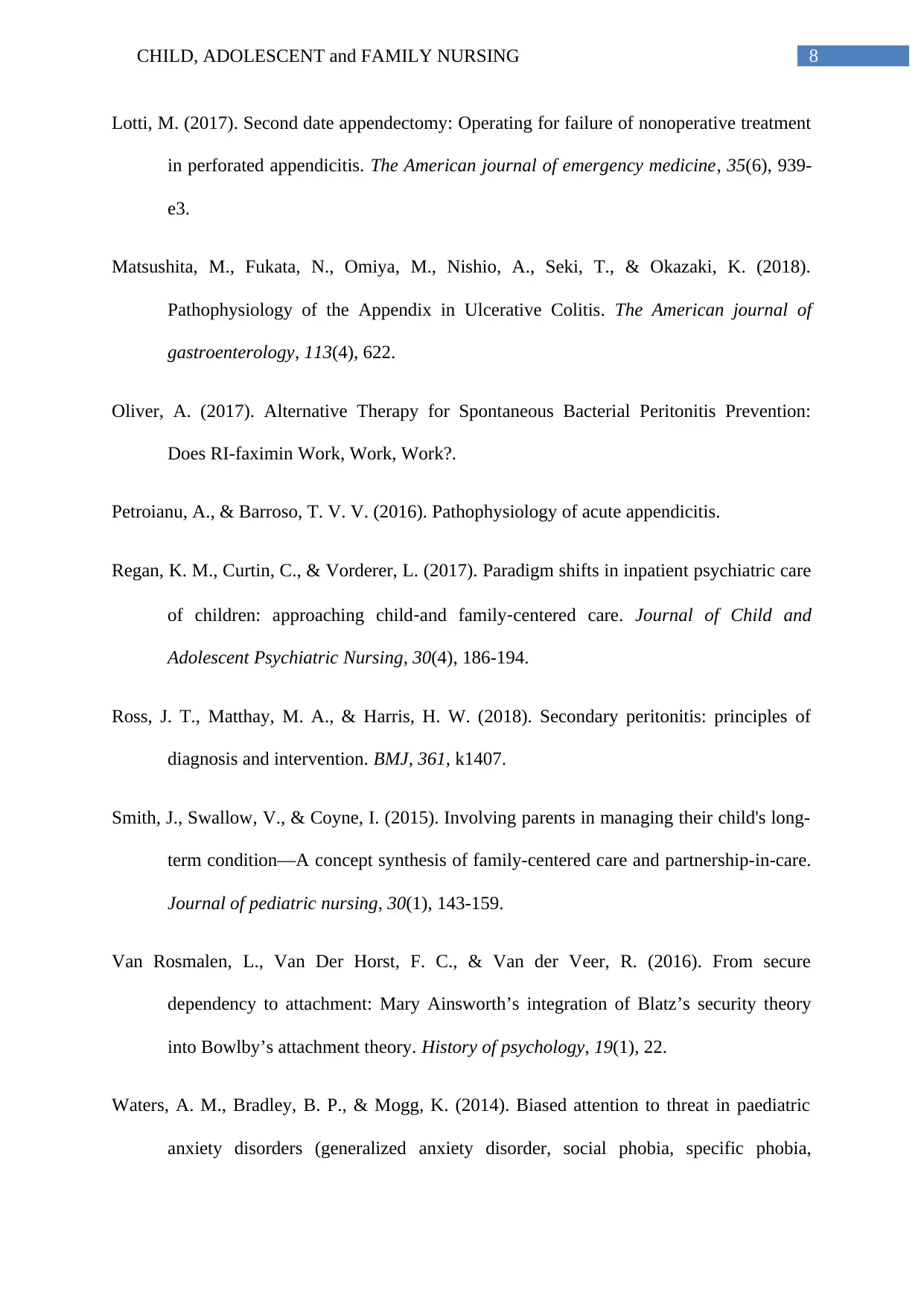
8CHILD, ADOLESCENT and FAMILY NURSING
Lotti, M. (2017). Second date appendectomy: Operating for failure of nonoperative treatment
in perforated appendicitis. The American journal of emergency medicine, 35(6), 939-
e3.
Matsushita, M., Fukata, N., Omiya, M., Nishio, A., Seki, T., & Okazaki, K. (2018).
Pathophysiology of the Appendix in Ulcerative Colitis. The American journal of
gastroenterology, 113(4), 622.
Oliver, A. (2017). Alternative Therapy for Spontaneous Bacterial Peritonitis Prevention:
Does RI-faximin Work, Work, Work?.
Petroianu, A., & Barroso, T. V. V. (2016). Pathophysiology of acute appendicitis.
Regan, K. M., Curtin, C., & Vorderer, L. (2017). Paradigm shifts in inpatient psychiatric care
of children: approaching child‐and family‐centered care. Journal of Child and
Adolescent Psychiatric Nursing, 30(4), 186-194.
Ross, J. T., Matthay, M. A., & Harris, H. W. (2018). Secondary peritonitis: principles of
diagnosis and intervention. BMJ, 361, k1407.
Smith, J., Swallow, V., & Coyne, I. (2015). Involving parents in managing their child's long-
term condition—A concept synthesis of family-centered care and partnership-in-care.
Journal of pediatric nursing, 30(1), 143-159.
Van Rosmalen, L., Van Der Horst, F. C., & Van der Veer, R. (2016). From secure
dependency to attachment: Mary Ainsworth’s integration of Blatz’s security theory
into Bowlby’s attachment theory. History of psychology, 19(1), 22.
Waters, A. M., Bradley, B. P., & Mogg, K. (2014). Biased attention to threat in paediatric
anxiety disorders (generalized anxiety disorder, social phobia, specific phobia,
Lotti, M. (2017). Second date appendectomy: Operating for failure of nonoperative treatment
in perforated appendicitis. The American journal of emergency medicine, 35(6), 939-
e3.
Matsushita, M., Fukata, N., Omiya, M., Nishio, A., Seki, T., & Okazaki, K. (2018).
Pathophysiology of the Appendix in Ulcerative Colitis. The American journal of
gastroenterology, 113(4), 622.
Oliver, A. (2017). Alternative Therapy for Spontaneous Bacterial Peritonitis Prevention:
Does RI-faximin Work, Work, Work?.
Petroianu, A., & Barroso, T. V. V. (2016). Pathophysiology of acute appendicitis.
Regan, K. M., Curtin, C., & Vorderer, L. (2017). Paradigm shifts in inpatient psychiatric care
of children: approaching child‐and family‐centered care. Journal of Child and
Adolescent Psychiatric Nursing, 30(4), 186-194.
Ross, J. T., Matthay, M. A., & Harris, H. W. (2018). Secondary peritonitis: principles of
diagnosis and intervention. BMJ, 361, k1407.
Smith, J., Swallow, V., & Coyne, I. (2015). Involving parents in managing their child's long-
term condition—A concept synthesis of family-centered care and partnership-in-care.
Journal of pediatric nursing, 30(1), 143-159.
Van Rosmalen, L., Van Der Horst, F. C., & Van der Veer, R. (2016). From secure
dependency to attachment: Mary Ainsworth’s integration of Blatz’s security theory
into Bowlby’s attachment theory. History of psychology, 19(1), 22.
Waters, A. M., Bradley, B. P., & Mogg, K. (2014). Biased attention to threat in paediatric
anxiety disorders (generalized anxiety disorder, social phobia, specific phobia,

9CHILD, ADOLESCENT and FAMILY NURSING
separation anxiety disorder) as a function of ‘distress’ versus ‘fear’diagnostic
categorization. Psychological medicine, 44(3), 607-616.
Wu, C. H., & Parker, S. K. (2017). The role of leader support in facilitating proactive work
behavior: A perspective from attachment theory. Journal of Management, 43(4),
1025-1049.
separation anxiety disorder) as a function of ‘distress’ versus ‘fear’diagnostic
categorization. Psychological medicine, 44(3), 607-616.
Wu, C. H., & Parker, S. K. (2017). The role of leader support in facilitating proactive work
behavior: A perspective from attachment theory. Journal of Management, 43(4),
1025-1049.
1 out of 10
Related Documents
Your All-in-One AI-Powered Toolkit for Academic Success.
+13062052269
info@desklib.com
Available 24*7 on WhatsApp / Email
![[object Object]](/_next/static/media/star-bottom.7253800d.svg)
Unlock your academic potential
© 2024 | Zucol Services PVT LTD | All rights reserved.





